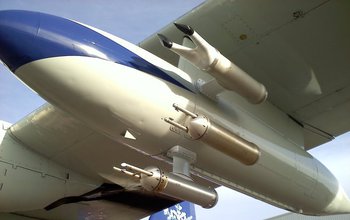All Images
News Release 15-121
Scientists use holography to peer into clouds
New way of seeing clouds enhances weather, climate predictions
This material is available primarily for archival purposes. Telephone numbers or other contact information may be out of date; please see current contact information at media contacts.

The HOLODEC instrument, or Holographic Detector for Clouds, is mounted to and transported via a C-130 aircraft.
Credit: NCAR
Download the high-resolution JPG version of the image. (314.2 KB)
Use your mouse to right-click (Mac users may need to Ctrl-click) the link above and choose the option that will save the file or target to your computer.

Not quite the Starship Enterprise, the C-130 is nonetheless a sophisticated airborne laboratory.
Credit: NCAR
Download the high-resolution JPG version of the image. (74.0 KB)
Use your mouse to right-click (Mac users may need to Ctrl-click) the link above and choose the option that will save the file or target to your computer.

HOLODEC, on the ground. Once aloft, it will allow research into droplets' interactions with light.
Credit: NCAR
Download the high-resolution JPG version of the image. (1.4 MB)
Use your mouse to right-click (Mac users may need to Ctrl-click) the link above and choose the option that will save the file or target to your computer.

With HOLODEC, atmospheric scientists can investigate clouds at the plane's wingtip.
Credit: NCAR
Download the high-resolution JPG version of the image. (867.1 KB)
Use your mouse to right-click (Mac users may need to Ctrl-click) the link above and choose the option that will save the file or target to your computer.

HOLODEC's tip allows researchers to measure the attributes of clouds at the droplet scale.
Credit: NCAR
Download the high-resolution JPG version of the image. (1.4 MB)
Use your mouse to right-click (Mac users may need to Ctrl-click) the link above and choose the option that will save the file or target to your computer.

Scientist Raymond Shaw and colleagues study the smallest part of clouds: water droplets.
Credit: Michigan Tech
Download the high-resolution JPG version of the image. (1.7 MB)
Use your mouse to right-click (Mac users may need to Ctrl-click) the link above and choose the option that will save the file or target to your computer.
